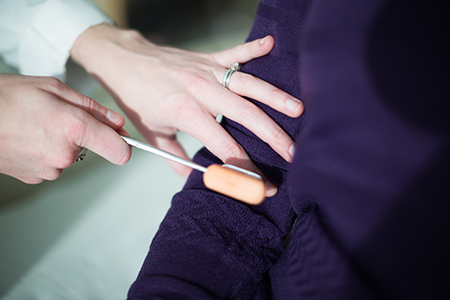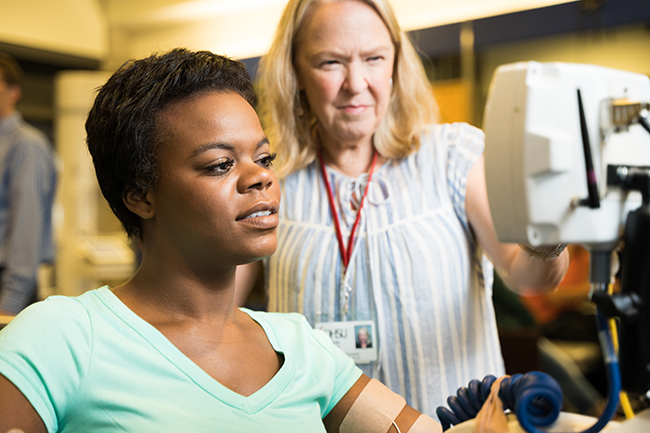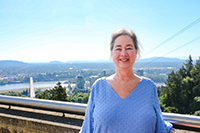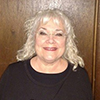Myopathy and Myositis
The ALS and Neuromuscular Disease Center provides complete care for nerve and muscle conditions, including all types of myopathy and myositis.
We offer:
- Team-based care from neuromuscular experts.
- A program dedicated to people with myositis, where we work with you to develop a custom treatment plan.
- Fast diagnosis using the latest tests, often with same-day results.
- Advanced treatment options, including therapy to build muscle strength and mobility.

Understanding myopathy and myositis
Myopathy and myositis are neuromuscular conditions that cause muscle problems, such as stiffness or weakness. Many people with these conditions have not been diagnosed or may have been misdiagnosed with another illness.
What are myopathy and myositis?
Myopathies: These are muscle diseases in which the muscle fiber doesn’t work properly. Myopathies cause problems with the muscles you use for voluntary movements such as walking or trying to grab something. Patients often have muscle stiffness or weakness.
Myositis: This is a type of myopathy that causes inflammation of your muscles, leading to weakness, swelling and pain.
Many people with a myopathy, including myositis, manage their symptoms and lead active lives. Medications can often relieve symptoms. In some cases, complete recovery is possible. Your outlook will depend on the type of myopathy you have and whether you have other health issues, such as a heart condition.
Who gets myopathy or myositis?
Myopathy and myositis can affect a wide range of people. Some forms are more common in children or adults, or more common in men or women.
With myositis, for example:
- Age: A type called dermatomyositis is the most common type in children.
- Gender: Two types, dermatomyositis and polymyositis, affect more women than men. A different type, inclusion body myositis, affects more men, usually over age 50.
What causes myopathy?
For some types of myopathies, known as idiopathic myopathies, the cause is unknown. Other types, called inherited myopathies, are caused by a genetic change passed down from parents. OHSU offers expert genetic testing and counseling to help you and your family identify and manage risk.
Other known myopathy causes include:
- Autoimmune diseases, when the body’s immune system mistakenly attacks its own muscles.
- Electrolyte disorders, in which production of electrolytes, substances that control bodily functions, is too high or too low.
- Myopathy caused by a medication, such as certain kinds of steroids and cholesterol-lowering drugs. This type is called drug-induced myopathy.
- Thyroid disease, in which the gland that helps regulate your metabolism under- or overproduces hormones.
- Virus or infection (including HIV and influenza) that invades and damages muscle tissue.
Types of myopathy and myositis
Types of myositis
These three rare conditions are also known as inflammatory myopathies because the muscles become inflamed and weak.
Dermatomyositis: The immune system attacks blood vessels that supply the muscles and skin, causing a skin rash along with hard bumps under the skin. It is rare, affecting one in 10 million adults per year.
Polymyositis: The immune system attacks muscle fibers. Muscle weakness makes it difficult to rise from a seated position or lift objects.
Inclusion body myositis: In addition to inflammation, people with inclusion body myositis also experience loss of muscle mass. This disease generally affects adults ages 50 and older.
Other myopathies
Necrotizing autoimmune myopathy: This rare disease is similar to polymyositis but with more severe and sudden symptoms. It is characterized by necrosis (cell death) in muscle tissue.
Metabolic myopathies: This group of diseases is caused by inherited genetic changes. These conditions affect the body’s metabolism, which in turn affects how we turn food into energy. Symptoms include muscle weakness and pain.
Types include:
- Acid maltase deficiency (Pompe disease): This type causes slow, progressive muscle weakness, especially in the muscles that control breathing and in the muscles in the legs, arms and torso. African Americans are at higher risk.
- Phosphorylase deficiency (McArdle disease): This type causes exercise intolerance — inability or difficulty exercising.
- Debrancher enzyme deficiency (Cori or Forbes disease): This type causes severe muscle weakness and liver dysfunction, which can lead to weight gain and abdominal pain.
Mitochondrial myopathies: This group of diseases affects the mitochondria, where our cells generate energy. Mitochondrial myopathies cause muscle weakness and neurologic difficulties such as seizures, hearing loss and difficulty balancing.
Symptoms of myopathy
Myopathies share some symptoms across types:
- Muscle weakness
- Fatigue, even from walking or standing
- Frequent tripping or falling
- Difficulty swallowing or breathing
Several types of myopathies have additional, specific symptoms.
Polymyositis:
- Difficulty getting up from a seated position
- Trouble lifting objects or reaching overhead
- Conditions such as arthritis, irregular heartbeat and congestive heart failure
Dermatomyositis:
- Skin rash
- Weight loss
- Low-grade fever
- Sensitivity to light
- Calcium deposits (hard bumps) under the skin
Inclusion body myositis:
- Weakness in fingers and wrists
- Difficulty with actions such as buttoning, gripping or pinching
Diagnosing myopathy
Most often, patients are referred to our center by their primary care doctor.
First appointment: You will meet with a team of specialists for a full evaluation. We will ask about your symptoms and medical history, and we will do a physical exam. We get many test results the same day so we can discuss next steps quickly.
Tests might include:
EMG: Our neuromuscular evaluation begins with an electromyography test, which takes about 30 minutes. An EMG measures electrical activities to tell doctors if there’s a problem with messages between your nerves and muscles.
Biopsy: We may suggest a muscle or skin biopsy to narrow your diagnosis. We take a small tissue sample, then send it to doctors called pathologists. They will analyze it under a microscope at our on-site lab, returning results in as little as one day.
Imaging tests:
- Ultrasound uses sound waves to create detailed images. An ultrasound of muscles can help doctors see if you have muscle inflammation.
- MRI (magnetic resonance imaging) uses radio waves and powerful magnets to create detailed pictures of your body. An MRI can help doctors locate muscle damage and identify changes to muscles over time.
Blood tests: A blood test can show high levels of muscle enzymes, a sign of inflammation. We may also use DNA from a blood test to look for genetic changes.

Treatment for myopathy
Myopathies have no cure, but our team strives to slow the disease and relieve symptoms. We can help you live more independently and comfortably.
Depending on your needs, your care team may include:
- Neuromuscular specialists
- Rehabilitation experts
- A dermatologist
- A rheumatologist
- Social workers
Your providers will work with you to develop an individual treatment plan. Options may include:
Medications to reduce inflammation. These might include:
- Steroids to reduce inflammation in your muscles and help you regain muscle strength. People typically take steroids as a pill, but they are also available through an IV.
- Immunosuppressants to reduce inflammation by stopping the immune system from attacking the body. These medications may be appropriate if your symptoms don’t respond to steroids.
Physical therapy: Our expert physical therapists have extensive experience with myopathies. They will work with your neurologist to plan the best approach for you. They will teach you how to keep your muscles moving to help you stay independent.
Occupational therapy: Our occupational therapists can help you continue daily activities such as eating, dressing and bathing.
Orthopaedic and assistive devices: Our team can help you select a cane, walker or wheelchair so you can stay mobile.
Advanced skin care: If you have dermatomyositis, we may recommend a steroid ointment to protect your skin. We also may advise sun precautions, such as sunscreen and protective clothing.
Support services: Our team of social workers can connect you with extra support and in-home care. They can provide counseling for you and your loved ones. They can also answer questions you may have about finances, Medicare or disability benefits.
Clinical trials
As an academic health center, OHSU offers many clinical trials to test new ways to prevent, detect and treat conditions. Participating in a trial may give you access to treatments or approaches that are not yet widely available.
Learn more
- Inflammatory Myopathies, American College of Rheumatology
- About Myositis, the Myositis Association
- Myositis Support and Understanding Association
For patients
- Referral: To become a patient, please ask your doctor for a referral.
- Nerve Center referrals: You may also be referred to us by the OHSU Nerve Center, where specialists direct patients to the team best able to treat them.
- Questions: For questions or follow-up appointments, call 503-494-5236.
Location
Parking is free for patients and their visitors.
OHSU ALS and Neuromuscular Disease Center
Center for Health & Healing Building 1, eighth floor
3303 S. Bond Ave.
Portland, OR 97239
Refer a patient
- Refer your patient to OHSU.
- Call 503-494-4567 to seek provider-to-provider advice.
Clinical trials
- Look for an OHSU Brain Institute clinical trial.
- Learn more about current clinical trials for patients with ALS or other neuromuscular disorders by contacting:
Diana Dimitrova, Ph.D.
503-494-7269Research assistants:
Solving a medical mystery

A grateful patient is on the mend after OHSU specialists trace her symptoms to a rare type of myositis and underlying cancer.
‘I am amazed’

Meet Tomasa, who went from being unable to lift her arms to “95% back to normal” after myopathy treatment at OHSU.